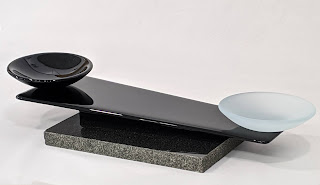Rolling Along with Mica Powders
 |
| Fused glass koi dish |
I have written previous blog posts with tips on getting the mica to better adhere to the glass surface. In the following tutorial, I'll show another way to use mica in your fused glass.
Materials
Clay texture roller (or other roller type with a design)
Black glass enamel (you'll want a true enamel like Thompson, not Glassline)
5x5" square of clear glass
(2) 5" strips of glass for border (width of tape, ~7/8")
5"x 3.125" dark-colored glass for center
Mica powder
Dust mask (when working with mica)
Dust mask (when working with mica)
Step-by-Step
 |
| Apply painters tape to glass |
 |
| Spread some enamel on a piece of float glass |
Spread enough enamel to coat the roller on a piece of glass. I use a piece of float glass.
Enamels come in premixed versions or they are dry and mixed with a medium prior to use. For this project, I have used Thompson high fire black, which comes dry, and I have mixed it with A14.
Note that whatever paint & medium you use, it should be at least somewhat slow-drying. In my experience, enamels mixed with Klyr-Fire, or pre-mixed Glassline paints, dry much too quickly. Screen-printing enamels are ideal because they have a fairly long working time.
 |
| Coat the texture roller with enamel |
Coat the texture roller with the enamel by rolling it in the paint on the float glass. Roll it back and forth several times until the roller is evenly coated. Add more enamel to the sheet of glass if needed.
 |
| Roll the enamel onto the clear glass |
Starting at the top or bottom edge, roll the enamel on to the masked off glass in a single motion. Don't roll back and forth -- this will blur the image.You'll notice my texture roller is just the right width to cover the area of the unmasked clear glass.
Don't worry if you don't get absolutely perfect coverage. Sometimes it's good to see "the hand of the artist"!
 |
| Sprinkle on mica powder |
Wearing a dust mask or respirator, sprinkle the mica over the enamel-covered glass. Tilt the glass back and forth, gently bumping an edge with your hand to distribute the mica evenly. You can use a single color of mica or use multiple colors. In the coral koi dish at the top of the tutorial, I have used a rose colored mica and a gold colored mica.
Once the mica is evenly distributed, carefully remove the tape. Hold the glass vertically and tap it on your working surface to knock off the mica that is not stuck to the paint. If you do all this mica work over a sheet of paper, you can recover and reuse what doesn't stick.
Now for the fun part...Once I've knocked off all I can, I take the piece outside and, using good ole lung power, I blow across the surface of the glass several times. This generally will remove all the mica from the unpainted glass surface, leaving your enameled surface nicely coated.
 |
| Bottom pieces of glass |
Now it's time to work with your three colored pieces of glass. I recommend using darker colors for the center glass. Here, my picture shows a white piece of glass. At the last minute, I changed this to black because the gold mica that I used would be mostly lost against a light background.
 |
| Lay-up in the kiln |
Place the three colored pieces of glass on shelf paper in the kiln (I like Papyrus). Top these pieces with the clear piece of enamel/mica-coated glass, mica-side up.
Let's talk a little about this lay-up. Given that we are capping three pieces of glass with a single piece, we've got major bubble trouble brewing because we are creating potential air pockets under the single-sheet cap. I mitigated the chances of bubbles in three ways: (1) placing the glass on shelf paper, rather than directly on the kiln shelf (this provides a way for air to escape); (2) accurately cutting the glass so the bottom pieces fit tightly together; and (3) a good bubble squeeze in my firing schedule.
Here is the schedule I used:
Segment
|
Rate
|
Target Temp
Deg F
|
Time (minutes)
|
1
|
300
|
1100
|
30
|
2
|
50
|
1250
|
60
|
3
|
300
|
1460
|
10
|
4
|
AFAP
|
950
|
60
|
5
|
100
|
700
|
00
|
The slow ramp in Segment 2 up to 1250 and the long hold at that temperature comprise the bubble squeeze.
After this full-fuse firing, I cleaned the piece and then slumped it using my usual schedule.
I hope the information above has given you ideas for creating unique glass pieces using texture rollers. More images can be found below!
Happy rolling! Dana
Want to learn more about fused glass? Click the banner below for information on Bullseye Glass' Educational Videos.

 |
| Close up of koi dish - rose and gold mica |
 |
| Blue small dish - vine-pattern texture roller |
 |
| Vine-pattern texture roller - front view |


